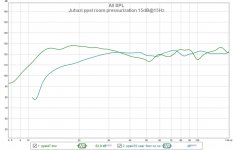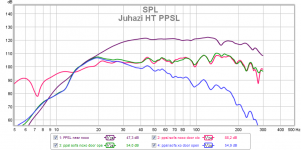That's weird, I'm listening to some dub reggae on my OB system, sounds ok to me, or perhaps it's that I'm channeling my former self who used to go to blues house parties in Handsworth Birmingham in the early 80s........
There is plenty of bass from the M-frame in the system I posted about earlier in this thread. It's just a folded open baffle. In a large room it has strong bass down to and below 30Hz. I posted an in-room response measurement HERE.No pressurization and NO BASS from an open baffle.
Check out the typical response on an IEC baffle, which is most likely a bit larger than what the OB "enthusiasts" use. 30Hz is 30db down, relative to 100, but how many times have I heard that OB bass is the bomb ? (too many)
What is a Frequency Response Chart? | Jensen Loudspeakers
To counter your example from Jensen, in this post I provided the uncorrected frequency response from my M-frame (left most attached plot) and in the following post I described the uncorrected sensitivity at various frequencies (since there is no "flat" reference passband). I think this is an example of a dipole bass system that can produce low frequencies with satisfying SPL.
If on the other hand you restrict your argument to "planar" open baffle systems, I would tend to agree. I have built a couple of speakers that used a planar baffle measuring from 18-24" wide and 30-40" tall with one or more woofers in the baffle and no side wings. These all tended to sound anemic in the bass, even when I attempted to correct the response using DSP. It was fine down to around 80-100Hz or so, but below that I concluded that it was rather pointless. Since then I have been using folded dipole subs from 100Hz down, mostly H-frame but also this latest M-frame (because I could shoehorn two drivers in each one that way) and this seems MUCH more satisfying in terms of bass output as long as the room can support it.
Perhaps, if the baffle was quite large, you were actually in or close to the nearfield? This will reduce cancellation at low frequencies. A large open baffle (large meaning over 1.5m across) is helpful in this regard, the larger the more so. But as JohnK pointed out to me once in the past with regard to a long H-frame, you are getting away from a dipole source and moving towards spatially distributed sources, and the usual models may not apply so well (as you have mentioned, Ben).My experience with a largish irregular shaped baffle was pretty satisfactory.
That's weird, I'm listening to some dub reggae on my OB system, sounds ok to me,
Haha LOL... it never ends...
//
Quite OK thank you. But how about you? Are you discussing "sound" or correct reproduction? If the former, it has no place here. If the latter, reagge dub is surely a studio production which sound is defined in the electronic realm. Which one?
//
//
Good, thank you for attempting to elucidate, the dub reggae sounded correctly reproduced to me, not lacking in any bass extension.
😉I'm channeling my former self who used to go to blues house parties in Handsworth Birmingham in the early 80s........
So the momentary pressurization causes a build up in bass below the room fundamental?Below the room fundamental the room can be though of as a big, leaky box. So a sealed box woofer is a woofer in a box, in a bigger box. Just as the pressure inside the woofer box changes as the cone moves in and out, the same thing happens in a room below the fundamental due to the net volume change. This can boost bass response below the room fundamental. With a dipole, since the is no woofer box to isolate the rear of the cone, there is no net change in room volume as the cone moves, thus, no pressurization.
So the momentary pressurization causes a build up in bass below the room fundamental?
Yes, but leakage limits the effect. A sealed box woofer is just a woofer in a box in a bigger box. Say the woofer cabinet is 3 ft^3. Say your room is 14 x 18 x 8 = 2016 ft^3. The cabinet loads the read side of the woofer, the room loads the front. But the pressure changes below the room fundamental would be 3/2016 = 0.00149 time smaller.
If you can handle a little math, here is a straight forward discussion of room pressurization mechanics from one of my old web pages.
roomgain
Thank you John, I will have a read of that. I'm trying to get my head around the term pressurization in this context and how it affects the bass

FWIW, these are my old flat baffle, open baffle system I built many, many years ago, circs 1980s, before the open baffle/dipole rage. Previously I had Dayton Wright XG10 MK III. They had their problems but I loved the style. So I build these with dynamic drivers, 2 x 12" woofers, 2x 10" woofers, 8" mid and 1" dome tweeter. Originally active bi-amped with all 4 woofers eq'ed for bass. Passive crossover between mid and tweeter as they were in the picture. Years later, with new drivers, they were quadre-amped with a dsp crossover. Bass wasn't a problem with either version.
Thank you John, I will have a read of that. I'm trying to get my head around the term pressurization in this context and how it affects the bass
It's not different. As you know, sound is just pressure fluctuations. Below the room fundamental the pressure variation just ceases to be that due to propagation of waves from the driver to the listeners and the excitation of resonant modes. As the wave length of the sound becomes large relative the room dimensions the pressure in the room basically varies homogeneously and is only a function of changes in volume of the enclosed area (room + woofer). So below the room fundamental there are no modes or standing waves. The sound pressure everywhere in the room is the same. In cars the call it's cabin gain.
While I understand the physics of an open baffle speaker not pressurizing a room, I have to say that once you get to a sufficient woofer cone area, it sure seems like it! I dunno, maybe there is a momentary imbalance in pressure that feels like room pressurization.
Once you get to two 18" woofers, four 15s or better yet four 18s in a typical domestic room it can get to a pretty good illusion of pressurization. 🙂
Once you get to two 18" woofers, four 15s or better yet four 18s in a typical domestic room it can get to a pretty good illusion of pressurization. 🙂
Well, it is very difficult to hear sinewave below 30Hz! With high spl we start to hear distortion and resonances of it first. Low F pressure waves can be felt with facial skin, some say...
Attachments
Last edited:
I forgot to say, that those are of a closed box 2x15" subwoofer in a 3x4m room. A friend has now 2x18" IB in a large leaky 6x7m room and 15-30Hz doesn't feel so intense! Perhaps it's just the lower distortion, I don't have saved measurements from there.
Last edited:
OB doesn't pressurise at DC, but where there's sound, there's pressure.
Please don't confuse sound propagation with room pressurization. What you hear at a given listening position is the product of the speaker's free field response with the listener at the same relative position (distance, height, angle) and the room transfer function between speaker and listener. The room transfer function found through modal analysis. Below is a figure showing the transfer function for monopole, cardioid and dipole sources in a 5m wide x 7m long x 3m high room. The first 4 figures show the result for different source positions while the listener is fixed at 2.5m x 5m x 1m. The 5th figure shows the result for the same source position as the 1st (top, left) figure but with the listener moved 1/2m to one side. Note the similarity in most cases but also note that below the room fundamental (about 24 Hz) the room transfer function for the dipole is basically flat to DC while the monopole and cardioid show a rising response as the frequency decreases due to the room pressurization.
It should also be noted that the dipole axis was aligned along a line from the corner of the room to the listener. With such an alignment the dipole is capable of exciting all room modes, indicating that in reality, with the speaker angled towards the listener, dipoles don't exhibit the claimed immunity to excitation of certain modes.

Last edited:
- Home
- Loudspeakers
- Multi-Way
- In Pursuit of a 20-20k Dipole Loudspeaker



